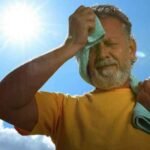After a rigorous workout or a long day of physical activity, sore muscles are often an unwelcome reminder of your efforts. However, incorporating light exercises and targeted stretches into your routine can help alleviate this discomfort and promote faster recovery.

In this blog post, we’ll explore five exercises specifically designed to relieve soreness and tension in your muscles, ranging from gentle walking to the therapeutic practice of foam rolling.
Light Walking:
One of the simplest yet most effective ways to ease sore muscles is through light walking. Taking a leisurely stroll around your neighborhood or on a treadmill can help increase blood flow to your muscles, reducing stiffness and promoting healing. Aim for a relaxed pace and focus on maintaining proper posture as you walk. Incorporating this low-impact exercise into your routine can provide immediate relief while also aiding in overall muscle recovery.
Light walking is an accessible and beneficial exercise for easing sore muscles. Its simplicity makes it an excellent choice for individuals of all fitness levels, including those recovering from injury or engaging in post-workout recovery. Here’s an elaboration on why light walking is so effective:
1. Increased Blood Flow: When you engage in light walking, your muscles contract and relax rhythmically, which promotes circulation throughout your body. This increased blood flow delivers essential nutrients and oxygen to your muscles, aiding in the repair process and flushing out metabolic waste products that contribute to soreness.
2. Reduced Stiffness: Sore muscles often feel stiff and tight, making movement uncomfortable. Light walking encourages gentle movement in your muscles and joints, helping to alleviate stiffness and improve flexibility. As you walk, your muscles gradually loosen up, allowing for greater range of motion and enhanced comfort.
3. Promotion of Healing: The increased blood flow and reduced stiffness resulting from light walking contribute to faster healing of sore muscles. By providing your body with the necessary resources and encouraging gentle movement, walking supports the repair and regeneration of damaged muscle fibers. This can help shorten recovery time and minimize the duration of muscle soreness.
4. Relaxed Pace and Proper Posture: It’s essential to approach light walking with a relaxed pace and mindful posture. Walking at a leisurely speed allows you to focus on the quality of your movement and prevents additional strain on already sore muscles. Maintaining proper posture, such as a straight spine and relaxed shoulders, helps distribute your body weight evenly and minimizes the risk of exacerbating muscle soreness or causing discomfort.
5. Overall Muscle Recovery: Incorporating light walking into your routine can have a cumulative effect on overall muscle recovery. By consistently engaging in this low-impact exercise, you support the body’s natural healing processes and help prevent future muscle soreness. Additionally, walking serves as an excellent active recovery strategy between more intense workouts, allowing your muscles to recover while still staying active.
Dynamic Stretching:
Dynamic stretching involves active movements that help improve flexibility and range of motion while also targeting sore muscles. Incorporate dynamic stretches such as leg swings, arm circles, and torso twists into your warm-up routine to prepare your muscles for exercise and reduce the risk of injury. These fluid movements gently elongate the muscles and increase blood flow, alleviating tightness and discomfort.
Dynamic stretching is a dynamic form of stretching that involves active movements performed in a controlled manner. Unlike static stretching, where you hold a stretch for a prolonged period, dynamic stretching involves moving through a full range of motion to stretch and warm up the muscles. Here’s an elaboration on why dynamic stretching is beneficial:
1. Improved Flexibility and Range of Motion: Dynamic stretching helps improve flexibility and range of motion by actively engaging the muscles and joints through a variety of movements. Unlike static stretching, which primarily targets the muscles in a stationary position, dynamic stretching allows for dynamic movement patterns that mimic those used during physical activity. This helps prepare the muscles and joints for the specific movements they will encounter during exercise, leading to improved flexibility and range of motion over time.
2. Targeting Sore Muscles: Dynamic stretching can be particularly effective for targeting sore muscles. By engaging in fluid movements that actively stretch and lengthen the muscles, dynamic stretching helps alleviate tightness and discomfort associated with muscle soreness. Additionally, the increased blood flow resulting from dynamic stretching promotes circulation to the affected muscles, aiding in the recovery process and reducing soreness.
3. Integration into Warm-Up Routine: Incorporating dynamic stretches such as leg swings, arm circles, and torso twists into your warm-up routine is an excellent way to prepare your muscles for exercise and reduce the risk of injury. Dynamic stretching helps increase blood flow to the muscles, raising their temperature and making them more pliable and responsive to movement. This prepares the muscles and joints for the demands of physical activity, reducing the risk of strains, sprains, and other injuries.
4. Fluid Movements: Dynamic stretching involves fluid, controlled movements that gently elongate the muscles without causing strain or discomfort. Unlike static stretching, which can sometimes be intense and uncomfortable, dynamic stretching allows you to gradually ease into each movement, making it suitable for individuals of all fitness levels. The fluidity of dynamic stretching promotes relaxation and encourages a mind-body connection, enhancing overall physical and mental well-being.
5. Alleviating Tightness and Discomfort: Dynamic stretching is particularly effective at alleviating tightness and discomfort in the muscles. By engaging in dynamic movements that actively stretch and lengthen the muscles, you can help release tension and improve muscle flexibility. This can lead to greater comfort during exercise and daily activities, as well as reduced risk of injury.
Yoga or Pilates:
Yoga and Pilates offer a variety of poses and exercises that can effectively relieve sore muscles and promote relaxation. Practices such as gentle yoga flows or Pilates mat exercises focus on controlled movements, deep breathing, and mindful stretching to release tension and improve muscle mobility. Incorporating these disciplines into your routine can not only alleviate soreness but also enhance your overall strength, balance, and flexibility.
Yoga and Pilates are both popular forms of mind-body exercise that offer a multitude of benefits, including relieving sore muscles and promoting relaxation. Here’s an elaboration on why incorporating yoga or Pilates into your routine can be beneficial:
1. Controlled Movements: Both yoga and Pilates emphasize controlled movements that engage multiple muscle groups simultaneously. In yoga, practitioners flow through a series of poses, while in Pilates, exercises focus on precise, controlled movements that target specific muscle groups. These controlled movements help improve muscle strength, endurance, and coordination while reducing the risk of injury.
2. Deep Breathing: One of the hallmarks of yoga and Pilates is the emphasis on deep, mindful breathing. Practitioners are encouraged to synchronize their breath with movement, which helps promote relaxation, reduce stress, and increase oxygen flow to the muscles. Deep breathing also helps release tension in the body, allowing for a deeper stretch and greater flexibility.
3. Mindful Stretching: Both yoga and Pilates incorporate stretching exercises designed to release tension and improve muscle mobility. These stretches are performed mindfully, with a focus on proper alignment and body awareness. By paying attention to how your body feels during each stretch, you can safely and effectively release tightness in the muscles, alleviating soreness and discomfort.
4. Strength and Stability: In addition to promoting flexibility, yoga and Pilates also help build strength and stability in the muscles. Many yoga poses and Pilates exercises require you to engage your core muscles to maintain balance and stability. As you progress in your practice, you’ll notice improvements in muscle tone, strength, and overall body awareness, which can help prevent future muscle soreness and injuries.
5. Overall Well-being: Beyond the physical benefits, yoga and Pilates also offer numerous mental and emotional benefits. The focus on mindfulness, deep breathing, and relaxation can help reduce stress, improve mood, and enhance overall well-being. Regular practice of yoga or Pilates can leave you feeling rejuvenated, energized, and better equipped to handle the demands of daily life.
Foam Rolling:
Foam rolling, also known as self-myofascial release, is a popular technique used to alleviate muscle tightness and trigger points. Using a foam roller, gently apply pressure to specific areas of soreness or tension in your muscles, rolling back and forth to release knots and increase blood flow. Focus on major muscle groups such as the calves, hamstrings, quadriceps, and back, gradually working out any areas of discomfort. Regular foam rolling can improve muscle recovery, reduce soreness, and enhance flexibility.
Foam rolling, also referred to as self-myofascial release, has gained widespread popularity as an effective technique for relieving muscle tightness, alleviating trigger points, and promoting overall muscle health. Here’s an elaboration on why foam rolling is beneficial:
1. Alleviation of Muscle Tightness: Foam rolling works by applying pressure to specific areas of tension or soreness in the muscles. As you roll back and forth over these areas, the foam roller helps to break up adhesions and knots, releasing tightness and restoring optimal muscle function. This targeted approach allows you to address areas of discomfort directly, providing immediate relief and improving overall muscle flexibility.
2. Reduction of Trigger Points: Trigger points, also known as muscle knots, are localized areas of muscle tightness that can cause pain and discomfort. Foam rolling can help alleviate trigger points by applying pressure to these areas and encouraging the release of tension. By targeting trigger points with a foam roller, you can help restore proper muscle function and reduce pain associated with muscle knots.
3. Increased Blood Flow: Foam rolling promotes increased blood flow to the muscles, which can help accelerate the recovery process and reduce post-exercise soreness. As you roll over the muscles with the foam roller, you stimulate blood flow to the area, delivering oxygen and nutrients that are essential for muscle repair and recovery. This enhanced circulation can help alleviate soreness and stiffness, allowing you to recover more quickly from intense workouts or physical activity.
4. Focus on Major Muscle Groups: Foam rolling allows you to target major muscle groups throughout the body, including the calves, hamstrings, quadriceps, and back. By focusing on these key areas, you can address muscle tightness and tension that may be contributing to discomfort or limiting range of motion. Regular foam rolling of these muscle groups can help improve flexibility, reduce the risk of injury, and enhance overall athletic performance.
5. Enhancement of Muscle Recovery: Incorporating foam rolling into your regular routine can help enhance muscle recovery and prevent overuse injuries. By releasing tightness and tension in the muscles, foam rolling can help prevent the buildup of adhesions and scar tissue, which can impede muscle function and lead to injury over time. Additionally, foam rolling promotes relaxation and stress relief, which can further aid in the recovery process and promote overall well-being.
Contrast Therapy:
Contrast therapy involves alternating between hot and cold treatments to promote circulation and reduce inflammation in sore muscles. Begin by applying a heat pack or taking a warm bath to dilate blood vessels and relax muscles. After several minutes, switch to a cold compress or immerse yourself in a cold water bath for a brief period to constrict blood vessels and reduce swelling. Repeat this cycle of hot and cold therapy several times to stimulate blood flow and accelerate muscle recovery.
Contrast therapy, also known as hot-cold therapy or contrast baths, is a therapeutic technique that involves alternating between hot and cold treatments to promote circulation, reduce inflammation, and alleviate sore muscles. Here’s an elaboration on why contrast therapy is beneficial:
1. Promotion of Circulation: Contrast therapy works by alternating between hot and cold temperatures, which causes the blood vessels in the body to constrict and dilate. When exposed to heat, such as a warm bath or heat pack, blood vessels expand, allowing for increased blood flow to the affected area. Conversely, cold temperatures, such as a cold compress or cold water bath, cause blood vessels to constrict, reducing blood flow. Alternating between hot and cold treatments stimulates circulation, flushing out metabolic waste products and delivering oxygen and nutrients to the muscles, which promotes faster healing and muscle recovery.
2. Reduction of Inflammation: Cold therapy, in particular, helps reduce inflammation and swelling in sore muscles. When muscles are inflamed due to injury or overexertion, cold temperatures cause vasoconstriction, which decreases blood flow to the area and reduces inflammation. This can help alleviate pain and discomfort associated with sore muscles and accelerate the healing process.
3. Relaxation of Muscles: Heat therapy, such as a warm bath or heat pack, helps relax tense muscles and relieve muscle spasms. Heat increases blood flow to the muscles, which helps improve flexibility and reduce stiffness. By alternating between hot and cold treatments, contrast therapy helps relax and soothe sore muscles while also reducing inflammation and promoting circulation.
4. Acceleration of Muscle Recovery: By promoting circulation, reducing inflammation, and relaxing muscles, contrast therapy accelerates the muscle recovery process. The alternating hot and cold treatments help flush out metabolic waste products, such as lactic acid, that can accumulate in the muscles during exercise or physical activity. This can help reduce soreness and fatigue, allowing for faster recovery and improved performance in subsequent workouts or activities.
5. Versatility and Accessibility: Contrast therapy can be easily incorporated into your routine using simple household items such as heat packs, cold compresses, or baths. It can be tailored to meet individual needs by adjusting the duration and intensity of the hot and cold treatments. Additionally, contrast therapy can be performed at home without the need for special equipment or supervision, making it a convenient and cost-effective option for promoting muscle recovery and alleviating soreness.
In summary, contrast therapy is a highly effective technique for promoting circulation, reducing inflammation, and accelerating muscle recovery. By alternating between hot and cold treatments, contrast therapy helps alleviate soreness, reduce swelling, and promote relaxation in sore muscles. Incorporating contrast therapy into your routine can help optimize muscle recovery and enhance overall physical well-being.
Conclusion:
Incorporating these five exercises into your routine can help alleviate sore muscles and promote faster recovery after intense physical activity. Whether you prefer gentle walking, dynamic stretching, yoga, foam rolling, or contrast therapy, finding the right combination of exercises that works for you is key to maintaining optimal muscle health and overall well-being. Remember to listen to your body, stay hydrated, and prioritize rest to ensure proper recovery and prevent injury. By incorporating these practices into your routine, you can keep sore muscles at bay and continue to enjoy the benefits of an active lifestyle.
Top 20 FAQs about Light Walking to Foam Rolling: 5 Exercises for Sore Muscles
1. What is light walking and how does it help with sore muscles?
- Light walking involves taking a leisurely stroll, which increases blood flow to the muscles, reduces stiffness, and promotes healing.
2. How often should I engage in light walking to alleviate sore muscles?
- Aim for at least 20-30 minutes of light walking on most days of the week to experience its benefits for sore muscles.
3. Can dynamic stretching be performed before or after a workout?
- Dynamic stretching is best performed before a workout to prepare the muscles for exercise and reduce the risk of injury.
4. Which muscle groups does dynamic stretching target?
- Dynamic stretching targets various muscle groups, including the legs, arms, and torso, to improve flexibility and range of motion.
5. Is yoga or Pilates more effective for relieving sore muscles?
- Both yoga and Pilates offer effective ways to relieve sore muscles, as they focus on controlled movements, deep breathing, and mindful stretching.
6. How long should I hold each yoga or Pilates pose to alleviate soreness?
- Aim to hold each yoga or Pilates pose for 20-30 seconds, breathing deeply and focusing on releasing tension in the muscles.
7. What is foam rolling, and how does it work to relieve muscle soreness?
- Foam rolling, or self-myofascial release, involves applying pressure to specific areas of soreness or tension to release knots and increase blood flow.
8. Which areas of the body can benefit from foam rolling?
- Foam rolling can target major muscle groups such as the calves, hamstrings, quadriceps, and back to alleviate soreness and tension.
9. How often should I foam roll to see improvements in muscle recovery?
- Aim to foam roll for 5-10 minutes before or after a workout, or whenever you experience muscle soreness, to promote muscle recovery.
10. Can contrast therapy be used to alleviate sore muscles? – Yes, contrast therapy, which involves alternating between hot and cold treatments, can help reduce inflammation and promote circulation in sore muscles.
11. How long should I apply heat during contrast therapy? – Apply heat for 15-20 minutes to dilate blood vessels and relax muscles before switching to cold therapy.
12. How long should I apply cold therapy during contrast therapy? – Apply cold therapy for 5-10 minutes to constrict blood vessels and reduce inflammation before switching back to heat therapy.
13. Can contrast therapy be performed at home? – Yes, contrast therapy can be easily performed at home using items such as heat packs, cold compresses, or baths.
14. How does contrast therapy accelerate muscle recovery? – Contrast therapy promotes circulation, reduces inflammation, and relaxes muscles, which accelerates the muscle recovery process.
15. Can contrast therapy be used for acute injuries? – Yes, contrast therapy can be used to reduce inflammation and promote healing in acute injuries, such as sprains or strains.
16. Is it safe to perform foam rolling on injured muscles? – It’s best to consult with a healthcare professional before foam rolling injured muscles to ensure it won’t exacerbate the injury.
17. Can I combine light walking with foam rolling for maximum benefits? – Yes, combining light walking with foam rolling can further promote circulation, reduce soreness, and enhance overall muscle recovery.
18. How soon after a workout should I engage in foam rolling? – You can foam roll immediately after a workout or wait until later in the day when you experience muscle soreness.
19. Are there any risks associated with foam rolling? – While foam rolling is generally safe, avoid rolling over bony prominences or applying excessive pressure to avoid bruising or tissue damage.
20. Can I perform dynamic stretching before foam rolling? – Yes, dynamic stretching before foam rolling can help prepare the muscles for deeper myofascial release and enhance the benefits of both practices.
Register for My Upcoming Masterclass HERE
See You in the Live Masterclass
Sunil Chaudhary stands as a preeminent global Leading digital coach, boasting a diverse clientele hailing from over 50 nations. Renowned for his prowess as an exemplary SEO expert, business automation coach, and landing page authority, Chaudhary also holds the distinction of being esteemed as the finest business coach in India. Beyond technical domains, he imparts invaluable insights into mindset, success, and life skills, thus encompassing a holistic approach to mentorship.
Join FREE Courses HERE
Know The Author:
 Sunil Chaudhary aka Suniltams Guruji is India’s Leading Digital Coach. He provides complete Digital Skill Development Coaching with great support. Sunil has trained more than 25000 students and helped more than 1100 businesses so far. Sunil is a well-known face across the world for Digital Coaching.
Sunil Chaudhary aka Suniltams Guruji is India’s Leading Digital Coach. He provides complete Digital Skill Development Coaching with great support. Sunil has trained more than 25000 students and helped more than 1100 businesses so far. Sunil is a well-known face across the world for Digital Coaching.
Digital Success Coach | Best SEO Coach India | Mindset Coach | Life Success Coach
Related posts:
 Discover 5 Respiratory Health Exercises for Late Winter: From Alternate Nostril Breathing to Pursed Lip Breathing
Discover 5 Respiratory Health Exercises for Late Winter: From Alternate Nostril Breathing to Pursed Lip Breathing
 When Should You Eat, Before or After Exercise?
When Should You Eat, Before or After Exercise?
 Cardio vs. HIIT: Which Workout is Better for Weight Loss?
Cardio vs. HIIT: Which Workout is Better for Weight Loss?
 Exploring the World of Yoga
Exploring the World of Yoga
 Chandra Namaskar: Practice this yoga asana to calm your mind, body, and soul
Chandra Namaskar: Practice this yoga asana to calm your mind, body, and soul
 The Silent Killer: Exploring the Health Hazards of Prolonged Sitting
The Silent Killer: Exploring the Health Hazards of Prolonged Sitting
 Weight Loss: 5 Household Chores That Can Actually Help Burn Calories and Melt Fat at Home
Weight Loss: 5 Household Chores That Can Actually Help Burn Calories and Melt Fat at Home
 Debunking Asthma Myths: 5 Misconceptions You Need to Know
Debunking Asthma Myths: 5 Misconceptions You Need to Know
 Heat Stroke in Summer: What are the causes and how to prevent it?
Heat Stroke in Summer: What are the causes and how to prevent it?










Can you be more specific about the content of your article? After reading it, I still have some doubts. Hope you can help me.